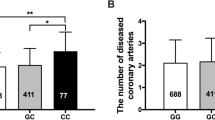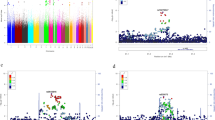Abstract
The human oxidised low-density lipoprotein receptor 1 (OLR1) gene is a functional candidate for atherosclerosis. An association of the OLR1 gene with acute myocardial infarction (AMI) or coronary artery disease (CAD) has recently been reported. In the present study a total of 677 Italian subjects, 327 CAD-free, 350 CAD, of which 190 with AMI and 160 AMI-free, was genotyped for the following four OLR1 single nucleotide polymorphisms: exon 4 K167N, IVS4 –73C>T, IVS4 –14A>G, and 3′UTR 188 C>T. No statistically significant difference was observed in allele or genotype distribution of the exon 4, intron 4, or 3′UTR SNPs in CAD patients compared to CAD-free subjects, or within CAD, in AMI patients compared to AMI-free patients. A correlation was found between the K167N G/G genotype and the increased number of obstructed vessels. Even if the OLR1 genotype frequency distribution data in CAD or AMI subjects here reported do not fully confirm the positive results of some other association studies, an association with a marker of CAD severity was observed.
Similar content being viewed by others
Log in or create a free account to read this content
Gain free access to this article, as well as selected content from this journal and more on nature.com
or
References
Winkelmann BR, Hager J : Genetic variation in coronary heart disease and myocardial infarction: methodological overview and clinical evidence. Pharmacogenomics 2000; 1: 73–94.
Auer J, Weber T, Berent R, Lassnig E, Lamm G, Eber B : Genetic polymorphisms in cytokine and adhesion molecule genes in coronary artery disease. Am J Pharmacogenomics 2003; 3: 317–328.
Mehta JL, Li DY : Identification, regulation and function of a novel lectin-like oxidized low-density lipoprotein receptor. J Am Coll Cardiol 2002; 39: 1429–1435.
Li D, Williams V, Liu L et al: LOX-1 inhibition in myocardial ischemia-reperfusion injury: modulation of MMP-1 and inflammation. Am J Physiol Heart Circ Physiol 2002; 283: H1795–H1801.
Li D, Williams V, Liu L et al: Expression of lectin-like oxidized low-density lipoprotein receptors during ischemia-reperfusion and its role in determination of apoptosis and left ventricular dysfunction. J Am Coll Cardiol 2003; 19: 1048–1055.
Welch CL, Bretschger S, Latib N et al: Localization of atherosclerosis susceptibility loci to chromosomes 4 and 6 using the Ldlr knockout mouse model. Proc Natl Acad Sci USA 2001; 98: 7946–7951.
Tatsuguchi M, Furutani M, Hinagata J et al: Oxidized LDL receptor gene (OLR1) is associated with the risk of myocardial infarction. Biochem Biophys Res Commun 2003; 303: 247–250.
Mango R, Clementi F, Borgiani P et al: Association of single nucleotide polymorphisms in the oxidised LDL receptor 1 (OLR1) gene in patients with acute myocardial infarction. J Med Genet 2003; 40: 933–936.
Chen Q, Reis SE, Kammerer C et al: Genetic variation in Lectin-like Oxidized Low-Density Lipoprotein Receptor 1 (LOX1) gene and the risk of coronary artery disease. Circulation 2003; 107: 3146–3151.
Ohmori R, Momiyama Y, Nagano M et al: An oxidized low-density lipoprotein receptor gene variant is inversely associated with the severity of coronary artery disease. Clin Cardiol 2004; 27: 641–644.
Girelli D, Friso S, Trabetti E et al: Methylentetrahydrofolate Reductase C677T mutation, plasma homocysteine and folate, in subjects from Northern Italy with or without angiographically documented severe coronary atherosclerotic disease. Evidence for an important genetic-environmental interaction. Blood 1998; 91: 4158–4163.
Martinelli N, Girelli D, Olivieri O et al: Interaction between smoking and PON2 SER311CYS polymorphism as determinant of the risk of myocardial infarction. Eur J Clin Invest 2004; 34: 14–20.
The International HapMap Consortium: The International HapMap Project. Nature 2003; 426: 789–796.
Acknowledgements
This project was supported by the Italian Ministry of Education, University and Research and Foundation ‘Cassa di Risparmio di Verona, Vicenza, Belluno e Ancona’. We thank professor Giuseppe Novelli (University of Rome Tor Vergata) for his suggestion on the intron 4 SNP genotyping method.
Author information
Authors and Affiliations
Corresponding author
Rights and permissions
About this article
Cite this article
Trabetti, E., Biscuola, M., Cavallari, U. et al. On the association of the oxidised LDL receptor 1 (OLR1) gene in patients with acute myocardial infarction or coronary artery disease. Eur J Hum Genet 14, 127–130 (2006). https://doi.org/10.1038/sj.ejhg.5201513
Received:
Revised:
Accepted:
Published:
Issue date:
DOI: https://doi.org/10.1038/sj.ejhg.5201513
Keywords
This article is cited by
-
LOX-1 variants modulate the severity of cardiovascular disease: state of the art and future directions
Molecular and Cellular Biochemistry (2023)
-
LOX-1, a new marker of risk and prognosis in coronary artery disease?
Molecular and Cellular Biochemistry (2013)
-
The LOX-1 3′UTR188CT polymorphism and coronary artery disease in Turkish patients
Molecular Biology Reports (2012)
-
SNPs of the FADS Gene Cluster are Associated with Polyunsaturated Fatty Acids in a Cohort of Patients with Cardiovascular Disease
Lipids (2008)
-
OLR1 gene and coronary artery disease/acute myocardial infarction: replication in an independently collected sample
European Journal of Human Genetics (2006)



